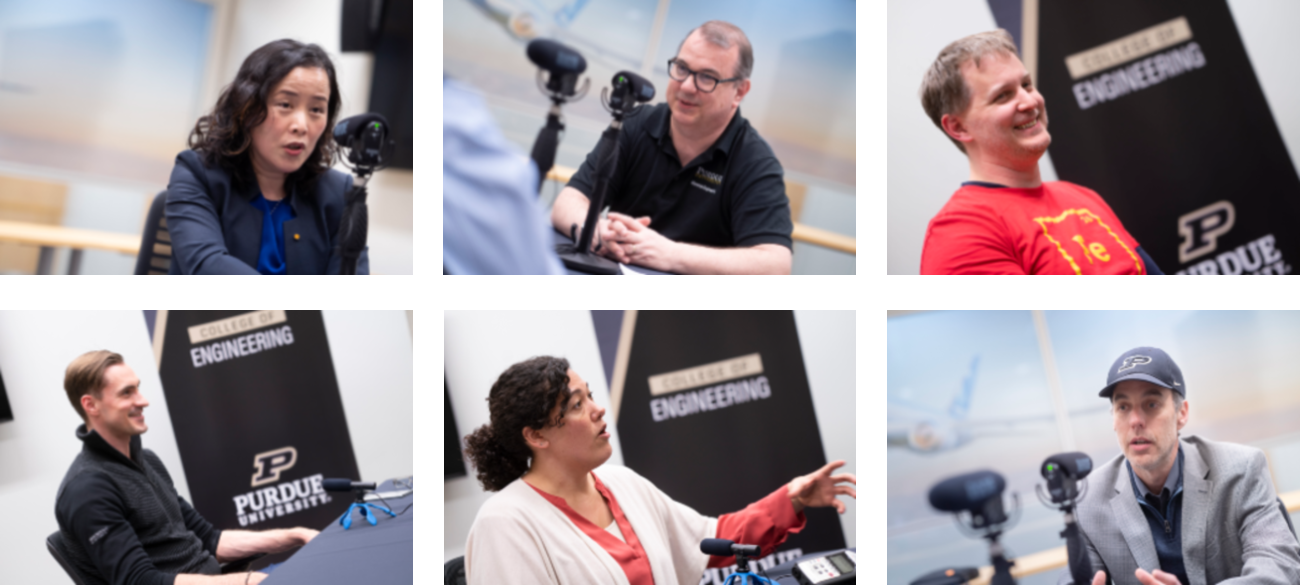MSE featured in CoE's podcast, 'Sounds Like the Future'
What's Next for MSE - From Ceramics to Nanotech, with David Bahr and Team: Part I, Episode 4
By William Schmitt
In March 2020, “Sounds Like the Future” presents two episodes featuring professors in the School of Materials Engineering (MSE).
This first episode introduces David Bahr, PhD, head and professor of materials engineering, who guides our tour of innovations and cutting-edge colleagues who have been part of big change at Purdue University’s College of Engineering.

The episode provides background on the growth of the School of Materials Engineering, which in its first 60 years has become the fifth-largest materials engineering program in the U.S.
New material groups have emerged continuously over 60 years, adding breadth and depth to a repertoire that at first was focused on metals. The spectrum now includes ceramics, polymers, electronic materials, biomaterials, energetic materials, and more. Nanomaterials are formed as thin films that may combine the properties of more than one kind of material. Some nanomaterials have the thickness of a single atom and are called two-dimensional materials. One such material comprising a single layer of atoms is called graphene.
Haiyan Wang, the Basil S. Turner Professor of Engineering, is a noted researcher in thin film composites suited to the nanostructures of next-generation computing devices. Among the devices being developed are those that could no longer be called microelectronics; they transmit information using photons, not electrons, so they bear the name “photonics.” Wang mentioned Professor Michael Manfra, who is focused on a different path toward quantum computing.
Professor Matthew Krane centers his materials engineering and mechanical engineering research around metals processing and microstructures that affect product efficiency, efficacy and sustainability. His manufacturing partners include companies in today’s steel industry, with its new demand for customized, advanced properties. Krane mentioned Professor Kenneth Sandhage, who is pursuing properties of intensive heat and corrosion resistance in materials that would provide heat-transfer functions in concentrated solar power plants.
Professor Jeffrey Youngblood works on polymers and other materials, such as ceramics, with a special focus on optimizing sustainability in products. His research seeks out natural materials, including cellulose, but all materials must be judged in light of a “triple bottom line” standard. Products must be functional, cost-effective and sustainable. One Purdue innovation, nano-cellulose-enabled concrete, has been used to pave a parking lot in South Carolina.
This triple bottom line also applies to development of such products as heat exchangers for turbine engines, a project in which Youngblood has joined forces with Professor Rodney Trice. They aim to reduce jet engines’ carbon footprint. Their collaborators include the Burke Laboratory, a mechanical engineering research facility emphasizing energy efficiency.
Professor Davin Piercey develops new energetic materials, such as explosives. One must address an array of safety and toxicity concerns in this field. The quality of replacement materials can be determined through small-scale experimentation. Piercey said the experimentalists enjoy the hands-on work but also benefit from the predictive skills of data scientists conducting simulations and modeling to assess different materials and properties.

What's Next for MSE -- From Ceramics to Nanotech, with David Bahr and Team: Part II, Episodes 5
By William Schmitt
This second episode of the two-part visit to the School of Materials Engineering (MSE) remains centered on the overview provided by David Bahr, PhD, head and professor and head of materials engineering. Again, comments from other faculty members with special areas of innovative expertise are interspersed throughout the conversation with Bahr.
Bahr told us ceramics are wide-ranging, from coffee mugs to glass windows to temperature-resistant materials for advanced applications. The complexity of making this last group of ceramics has prompted new research on more cost-effective, smaller-scale “additive manufacturing” of ceramics. These processes are akin to additive manufacturing of polymers and the 3D printing techniques increasingly common in workplaces.
Professor Rodney Trice, mentioned in the previous episode, spoke of ceramics in the context of an urgent challenge now confronted in the defense arena. Materials for hypersonic missile flight must be extremely heat-resistant, as well as resistant to oxidation. Trice is part of a large community of industry and academic researchers pursuing ceramic innovation.

Professor Chelsea Davis exemplifies interest in measurement of adhesion strength between materials. One project for which she leads a team of students, along with Professor Kendra Erk, addresses the road-signage needs of the Indiana Department of Transportation. Davis has seen how MSE prepares students to work in a wide range of applications.
In another testimony to the variety of career paths for materials engineers, Bahr pointed out that one of the School’s faculty members, Professor Jan-Anders Mansson, will oversee Purdue’s new Ray Ewry Sports Engineering Center.
Bahr said the School’s comprehensive materials know-how fits well with the broad visioning taking place in the five Purdue Engineering Initiatives. Those PEIs are virtual structures for incubating innovations connecting principal trends in engineering to the College’s distinctive strengths for ongoing leadership.
One early example of the intersection between MSE’s resources and the path toward top-priority impacts in engineering is nanoHUB, Bahr said. The international materials community has embraced the nanoHUB tools that were created by Purdue engineers. That places the School at the heart of planning for future applications of computational resources and data science.
Professor Alejandro Strachan is one representative of MSE’s early and ongoing momentum in using data to advance materials research. He said the ability to use predictive modeling based on physics has already helped to accelerate engineering. Bahr said the School and its extended community will continue to be a crucial part of the teamwork that makes Purdue a leader in engineering.
Message from Department Head: https://engineering.purdue.edu/Engr/AboutUs/News/Events/120/120th-message/March2020
Source: https://engineering.purdue.edu/podcast/sounds-like-the-future
